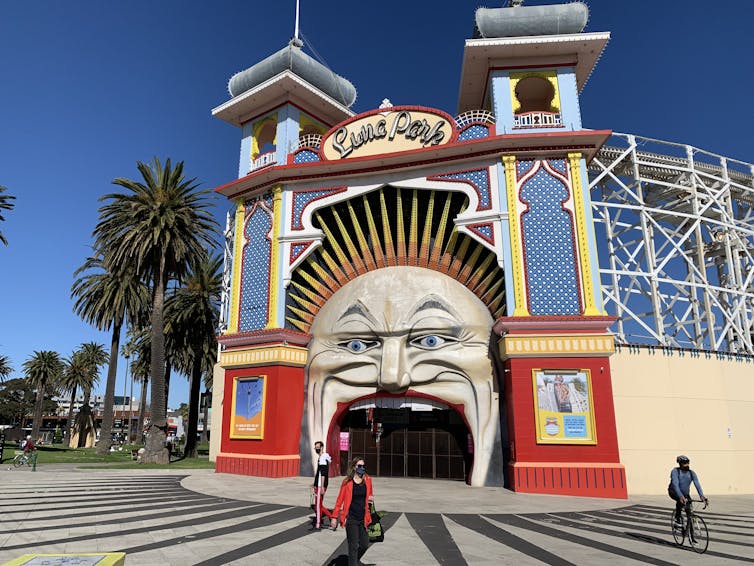Source: The Conversation (Au and NZ) – By Alexa Gower, Postdoctoral researcher, Monash University
Melbourne has endured one of the strictest COVID-19 lockdowns in the world. Public health announcements indicate restrictions are set to continue despite experts warning that Victoria is unlikely to get the daily average number of new cases down to just five in the near future.
Our research shows some people lack access to the essential services and amenities that support healthy and liveable places during the lockdown. We tracked 80,000 location-based tweets from January 2020 to September 2020 to understand how people are responding to Melbourne’s lockdowns.
Social media such as Twitter can provide a window into how people are emotionally managing during the lockdown and how well their neighbourhood meets their needs in this challenging time. This is particularly important as policy conversations turn to the importance of 20-minute neighbourhoods and living locally in the post-COVID city.
Read more: People love the idea of 20-minute neighbourhoods. So why isn’t it top of the agenda?
Research has shown the inequality of neighbourhood access to services and amenities can have serious physical and mental health impacts. These differences raise issues of equity and whether responses are proportionate to the threat. It also means some neighbourhoods are ill-equipped to support the anticipated increase in people working from home during and after the pandemic.
Read more: Our cities are full of parks, so why are we looking to golf courses for more open space?
Life under lockdown isn’t the same for all
On August 2, the Victorian government established strict restrictions on movement including a 5km travel bubble and curfew in Melbourne. In a cross-discipline collaboration between Monash’s Art, Design & Architecture and Data Futures Institute, our analysis of Twitter data focused on neighbourhood amenity and opportunity at this point. Our findings reveal the differences in resident well-being across different suburbs during lockdown.

With the introduction of the first lockdown, the number of tweets posted about people’s local neighbourhoods increased by 158% compared to January and February 2020. This highlights how the lockdown turned people’s attention towards their residential area. It also indicates neighbourhood amenities became more significant for people who are no longer commuting to work in Melbourne’s CBD or other places.
People living in areas with poor access to amenities expressed higher levels of negative sentiment about their neighbourhood during the lockdown periods. Sentiment in these areas dropped three times in the year. There was a 13% drop in sentiment in March when the first lockdown came in and another 15.5% fall with the June lockdown 2.0. Sentiment continued to fall by 30% in August.
In contrast, tweets about amenity-rich areas revealed a 4% rise in positive sentiment. These residents detailed how their neighbourhood amenity helped their well-being during this time.

Read more: Twitter posts show that people are profoundly sad – and are visiting parks to cheer up
Missing aspects of going to work
We also see that not everyone is as supportive of remote working arrangements as some studies claim. Before the lockdown, tweets about places in Melbourne often highlighted satisfaction with working environments. These tweets spoke of walking between meetings, and places to gather and eat out:
Beautiful day in the city – just perfect for walking between meetings and lunch at the cafe. (Outer Melbourne, March 6).
Under lockdown, the number of tweets with negative sentiment about residential neighbourhoods throughout Melbourne increased by 124%. People posted negative opinions about what was missing from their local area and expressed longing for the amenities found in their workplace. People also missed their daily commute and the opportunity to walk between places outside their neighbourhood:
Although I’m loving working from home, one thing that I really miss is my walk to the office from the station. (Outer Melbourne, July 9).
Moreover, tweets highlighted that some people don’t have enough space to work from home
When I am working at home I’m currently sharing space with the indoor clothes hangers. (Outer Melbourne, April 16).
These tweets remind us of the challenges some people face when working from home and indicate how commuting enables access to amenities that their neighbourhoods lack.
Some areas make work from home a joy
In comparison, tweets that expressed positive neighbourhood sentiment during the lockdown referred specifically to the benefits of parks and public facilities. In high-amenity areas, people expressed gratitude for these places.
Social isolating done right … I’m so #grateful to have these sort of parks right on my doorstep so I can exercise both me and the dogs ?? (Inner Melbourne, March 29)
Being able to experience the natural environment improved their mood.
I went outside for a walk and took a moment to stand in a spot where the onshore bay breeze could freely hit me in the face while I listened to Sign ☮️ the Times. I needed that so badly. #starfishandcoffee’ (Inner Melbourne, April 16)
Some were happy to spend more time locally even when lockdown measures had eased.
The joys of working from home and walking to support our local coffee shop. Then you are pleasantly surprised by Teddy and his marmalade skills. Just sweet! (Outer Melbourne, May 27)
Increased positive sentiment about local amenity continued longer into the year than negative tweets, highlighting the broad benefits local amenities provide to communities.

Work to be done on neighbourhood amenity
Comparing Melbourne’s Twitter data across different places provides insight into the impacts of neighbourhood amenity on resident well-being during lockdown. It also shows the uneven access to important neighbourhood facilities in different places and the consequences for remote working.
The lockdown experience highlights that if Melbourne is serious about achieving a city of 20-minute neighbourhoods, there is immediate work to do to improve access to everyday amenities and support remote working.
Read more: Reclaiming the streets? We all can have a say in the ‘new normal’ after coronavirus
– ref. How’s your life under lockdown? Tweets tell the tale of how neighbourhoods compare – https://theconversation.com/hows-your-life-under-lockdown-tweets-tell-the-tale-of-how-neighbourhoods-compare-147839








